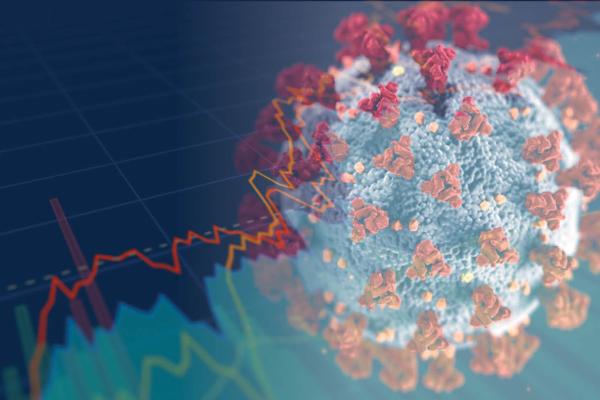NIH awards economics researchers $2.3M to study health, economic impacts of COVID-19

Even now — nearly two years after the pandemic began — the totality of COVID-19’s ever-evolving health and economic consequences remain unclear.
The pandemic’s ripple effect has impacted a multitude of interconnected variables leading to a staggering array of outcomes. A team of Ohio State researchers in the Department of Economics was recently awarded a five-year, $2.3 million grant from the National Institute on Aging, the National Institute on General Medical Sciences and the Office of the Director, all at the National Institutes of Health (NIH), to develop a model that defines and quantifies those variables in an effort to simulate the pandemic’s impacts and the policy responses to it.
The project, “The Health and Economic Impacts of COVID-19 and Policy Responses,” aims to provide a comprehensive portrait of COVID-19, making it possible to identify the best sets of economic and health outcomes, including infections and mortality, that could have been achieved, as well as the policies that would have led to best-case scenario outcomes. The model will also allow researchers to identify the ways in which enacted policies strayed from the best possible policies, providing a clearer picture of the health and economic costs of deviating from optimal policies overall and for specific demographic groups.
“This project tries to provide rigorous quantitative evidence to help us understand the costs and benefits of various COVID-19 mitigation policies, both in terms of health — and to the extent that we can, mental health — and economic outcomes,” said principal investigator Bruce Weinberg, a professor in the Department of Economics.
“How much of a trade-off is there? What do those trade-offs look like? Maybe if we could get the COVID-19 rates down, we can go about our lives in a more normal way and have a better economy. Those are the questions I’m hoping we can answer.”

Hanbat Jeong is a postdoctoral scholar of economics whose research focuses on econometrics, which uses statistical methods and quantitative data to understand economic relationships, and he previously developed an epidemiological model for COVID-19. His expertise is key in developing this project’s model, which is constructed with four primary features:
- First, it supports two-way interactions between infection rates and economic outcomes. Though COVID-19 is fundamentally a public health issue, it is essential to determine how those health-related consequences affect the economy and how, in turn, those economic consequences impact physical and mental health.
- Second, the model incorporates how policy responses across different jurisdictions account for geosocial spread. For example, the city of Columbus’ mask mandate was stricter than the city of Delaware’s mask mandate. Is there a geographic spillover of infection, and if so, how much?
- Third, the model allows for latent COVID-19 infections. Because of limited testing capabilities, gauging infection rates during the pandemic’s early stages was imperfect, thus undervaluing the pandemic’s true spread.
- The final feature accounts for disparate impacts across demographics, a critical component considering the pandemic’s effects across age, gender, race and class.
While the model will help assess the response to the pandemic, it will also help inform decision-making in the future. The researchers also hope the model can serve as a framework with which to build out a similar model for the opioid epidemic.

“The value of the model is not purely retrospective,” said Kurt Lavetti, associate professor of economics. “It also allows us to have infrastructure in place so that if another pandemic were to come or if there’s a new variant of COVID, we can input those parameters into the model and have a shovel-ready way of thinking about potential spillovers, consequences and geographic connections.”
Though this particular project was only recently awarded funding, its roots date all the way back to April 2020 — about a month after the pandemic prompted nationwide lockdowns — when Ohio State’s Office of Research launched its COVID-19 Seed Funding program.
The program was aimed at fast-tracking funding to coronavirus research and supported six studies, including this team’s work, in its initial round of support. At the time, the team was specifically examining the economic impacts of COVID-19, the policy responses to it and how those responses affected different types of workers.
As the research scope expanded, the team grew and additional funding arrived to supplement the original support from the COVID-19 Seed Funding program. Funding from the College of Arts and Sciences’ Institute for Population Research was critical in gathering economic and health data.

“That was crucial to studying the responses of economic activity and the co-evolution of economic activity and health over the pandemic,” said Meta Brown, associate professor of economics, “particularly with the objective of measuring refined time intervals, refined geography and subgroups of the population.”
Further support from National Center for Advancing Translational Science via The Ohio State University Center for Clinical and Translational Science and the National Institute on Aging via the National Bureau of Economic Research were vital in not only building out the project, but in capturing the NIH's attention.
“That all allowed us to get going and generate the kinds of preliminary results we needed,” Weinberg said. “I know some of the people who submitted to this NIA request for applications, and it was extremely competitive. This isn’t the type of thing you’re getting funded if you’re just like, ‘Oh, hey, I have this really cool idea so give me a million bucks.’ This is something where you show up with your A-game, your preliminary results, your well-developed model. That initial funding really put us in a position to be competitive.”
